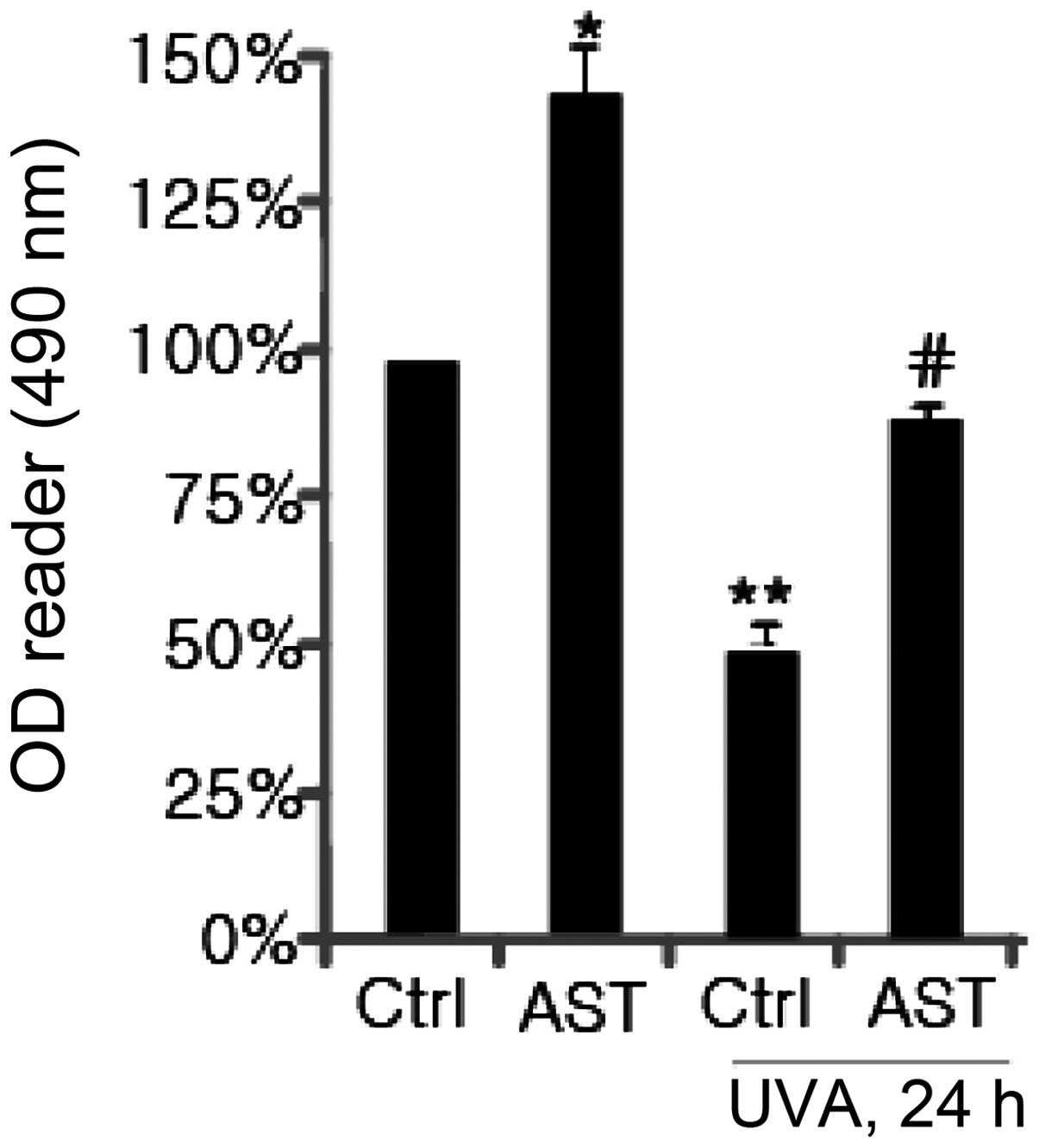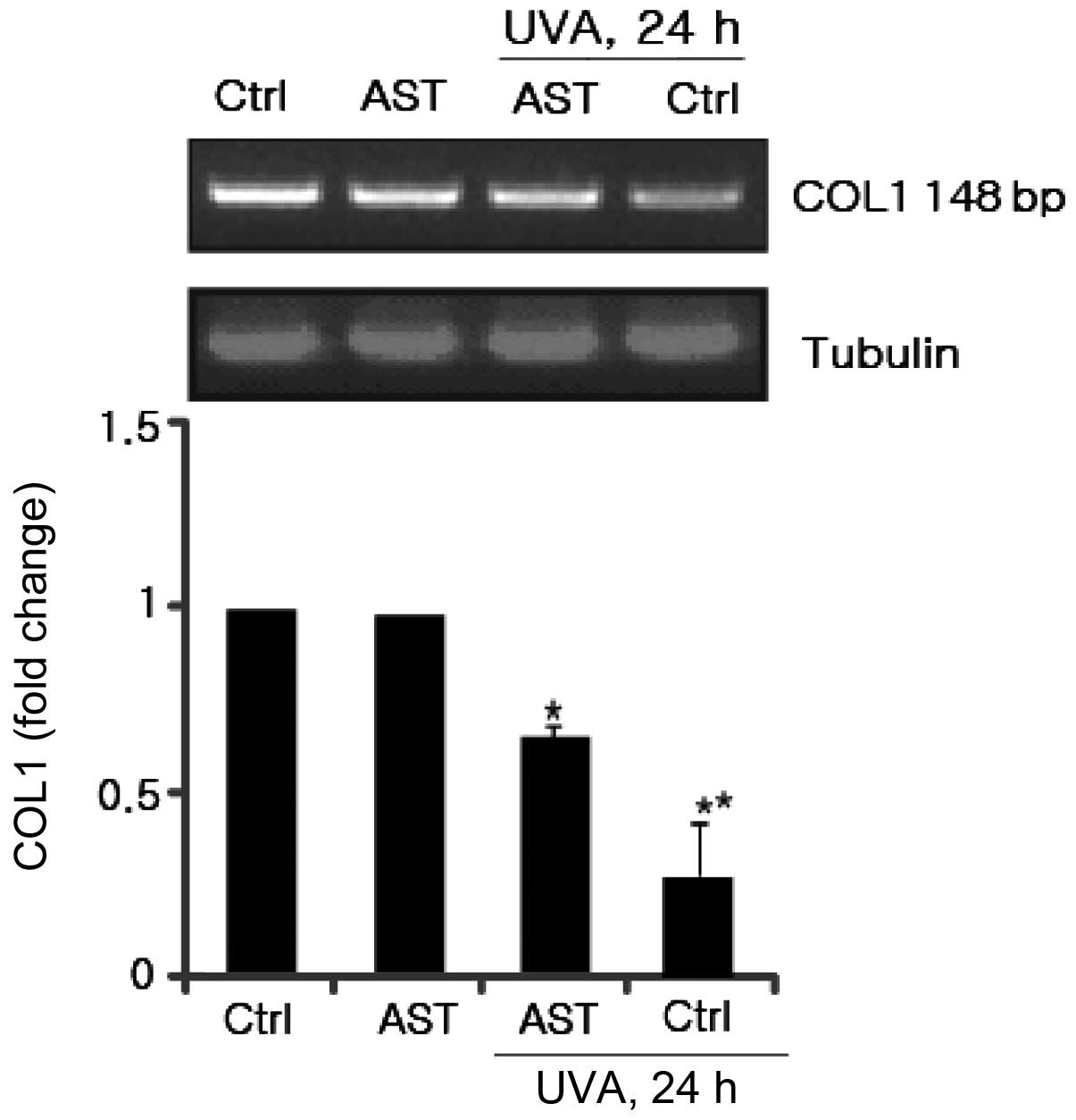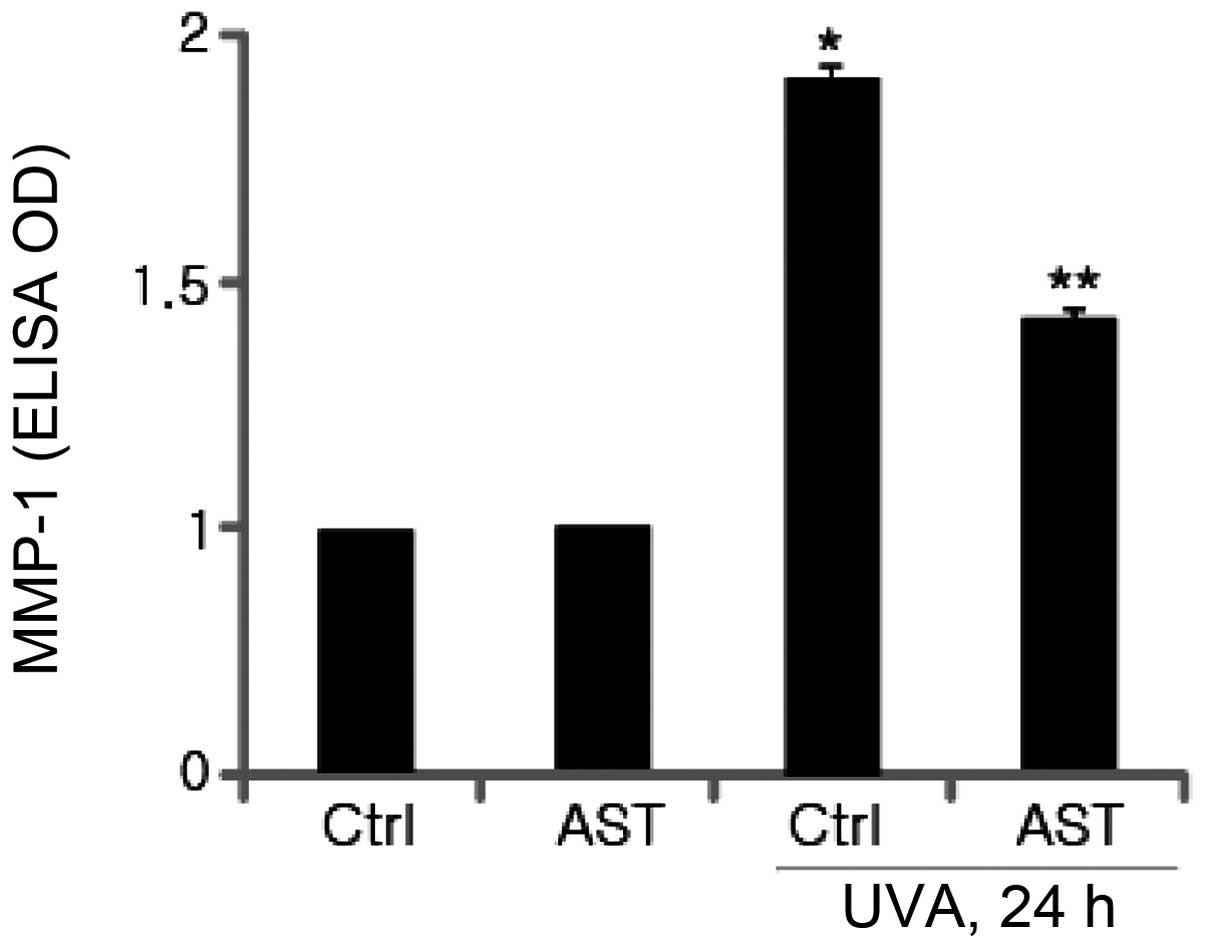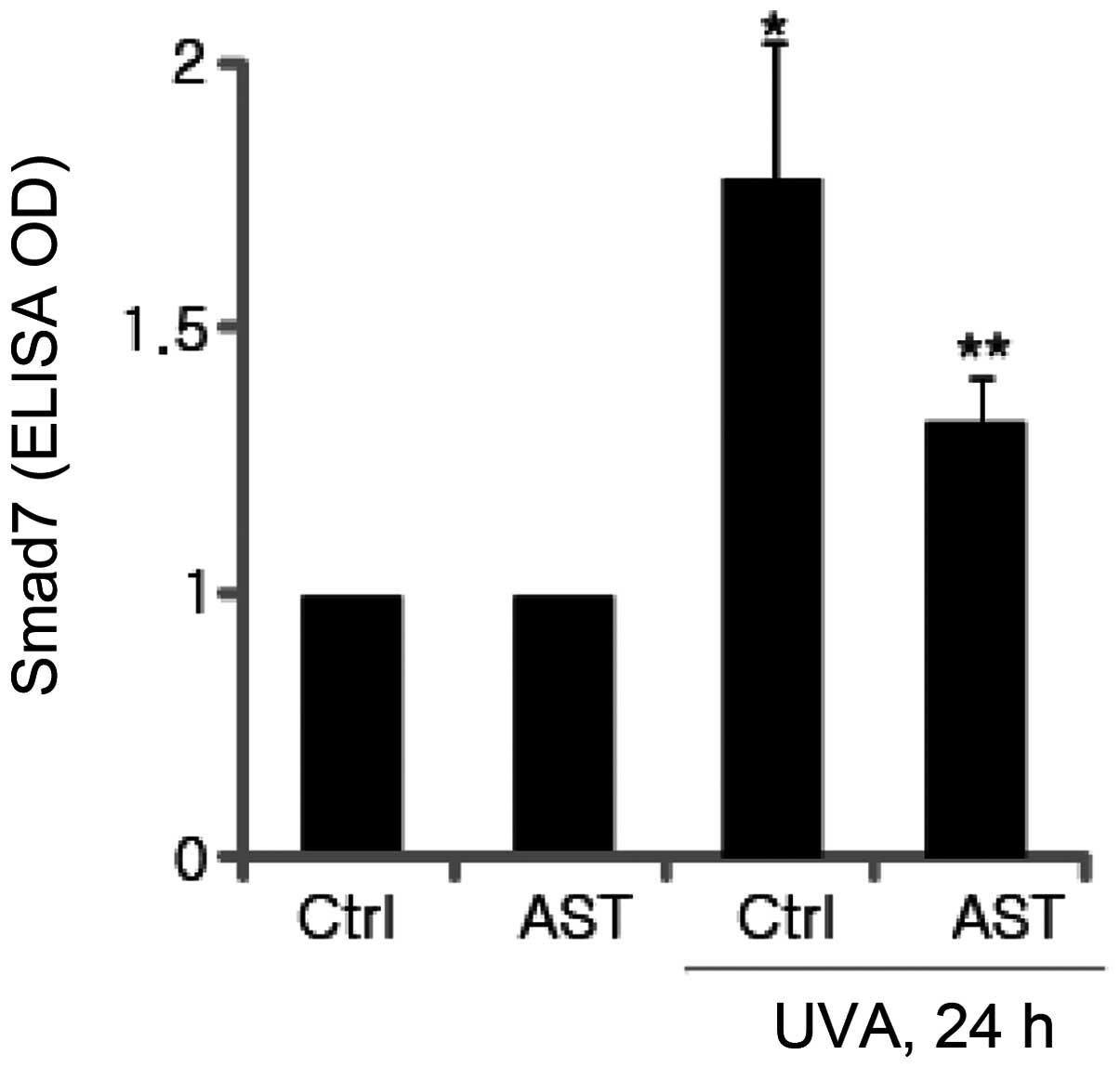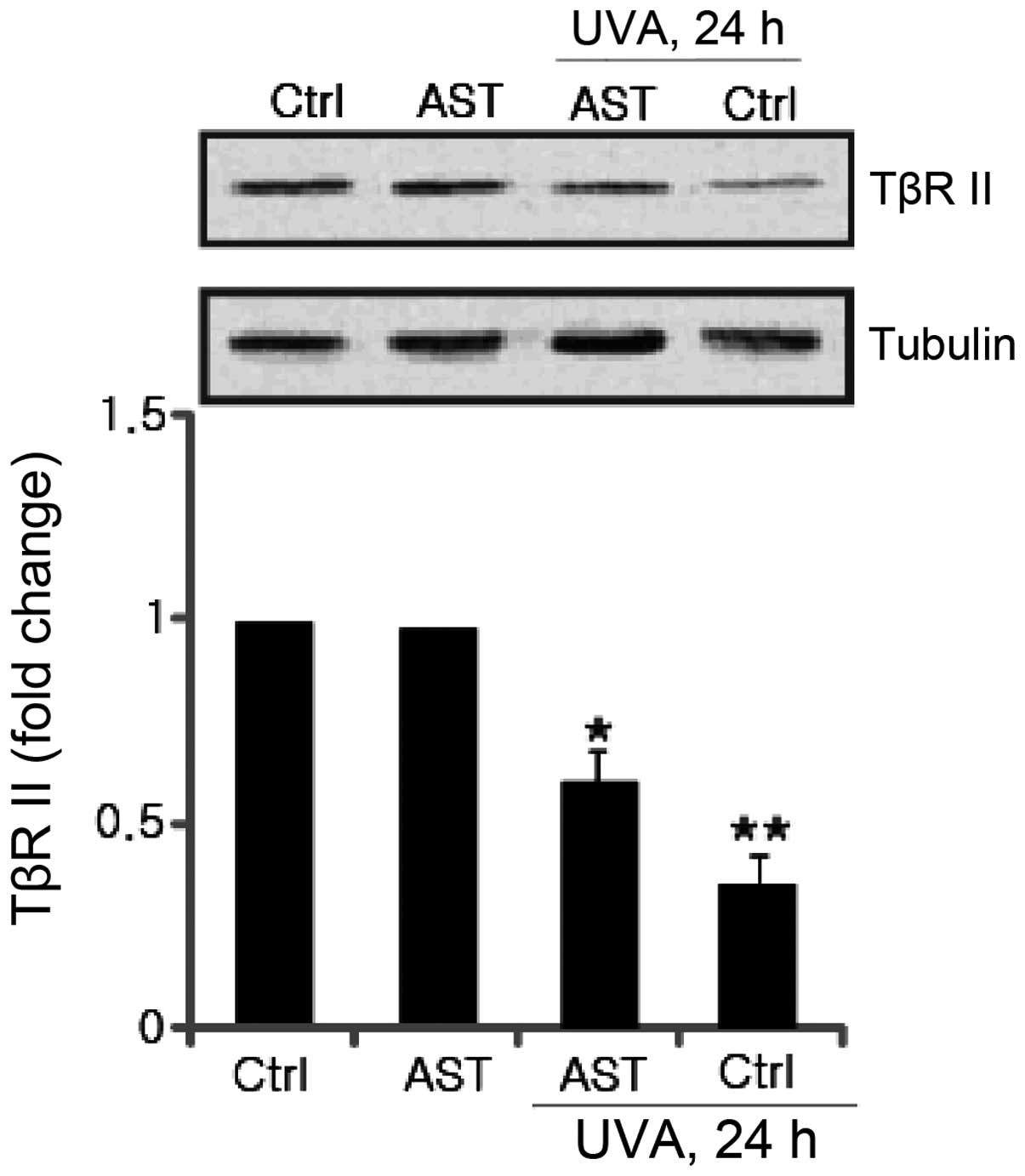Astragaloside IV controls collagen reduction in photoaging skin by improving transforming growth factor-β/Smad signaling suppression and inhibiting matrix metalloproteinase-1
- Authors:
- Published online on: January 16, 2015 https://doi.org/10.3892/mmr.2015.3212
- Pages: 3344-3348
-
Copyright: © Chen et al. This is an open access article distributed under the terms of Creative Commons Attribution License [CC BY_NC 3.0].
Abstract
Introduction
Ultraviolet (UV) irradiation impairs human skin and causes premature skin aging (photoaging), which results in deep wrinkles and pigment formation (1,2). Type I collagen, the most abundant structural protein in skin connective tissue, is essential for maintaining the strength and elasticity of the skin. Disorganization, fragmentation and dispersion of collagen bundles are three characteristics in human photoaging skin (1,3). Destroying the structural integrity of the collagenous extracellular matrix is well-established to be the major reason for the wrinkled appearance of photoaged skin (4). UV irradiation decreases type I collagen through two interdependent pathways: Stimulation of collagen degradation and inhibition of type I procollagen (COL1) production (3,5). Thus, UV-induced control of type I collagen production is one of the critical factors in the mechanism of photoaging.
Transforming growth factor-β (TGF-β) is the primary regulator of collagen synthesis in human skin (6–9). TGF-β functions by binding to specific receptor complexes, including TGF-β type I (TβRI) and TGF-β type II (TβRII) receptors on the cell surface (9). Smad7 is one of the negative factors in the TGF-β/Smad signaling pathway, which interacts with TβRI to prevent activation of Smad2/3, thereby inhibiting TGF-β signaling. It has been reported that UV irradiation impairs TGF-β/Smad signaling through downregulating the transcription of TβRII. This impairment is a major reason for the reduced procollagen synthesis in human skin fibroblasts (10). For this reason, the prevention of UV-induced loss of TβRII may precede the recovery of type I collagen reduction in photoaging skin.
UV irradiation leads to direct or indirect DNA damage and the formation of radical oxygen species, which causes the subsequent activation of complex signaling pathways, followed by the induction of matrix metalloproteinases (MMPs) in skin cells. MMPs are a group of extracellular matrix (ECM) enzymes, which can degrade the protein components of the ECM (11). Upregulation of MMPs, particularly collagenase-1 (MMP-1), generated by several types of cells, including fibroblasts, keratinocytes, endothelial cells, macrophages, hepatocytes, chondrocytes and osteoblasts, is responsible for the lysis of dermal collagen in skin aging.
Astragaloside IV (AST) is a small molecular saponin with multiple activities under pathophysiological conditions, including antihypertensive, positive inotropic action, anti-inflammatory and anti-infarct properties. However, the effect of AST in photoaging skin remains to be elucidated. The present study focused on whether AST prevents collagen degradation in photoaging skin and the possible underlying mechanisms, in vivo and in vitro to determine whether AST inhibits collagen reduction in photoaging skin by improving TGF-β/Smad signaling suppression and inhibiting MMP-1.
Materials and methods
Chemicals and reagents
Rabbit polyclonal immunoglobulin G (IgG) anti-TβRII (sc-220) and mouse monoclonal IgG2b anti-tubulin (sc-23950) antibodies were purchased from Santa Cruz Biotechnology, Inc. (Dallas, TX, USA).
Cell culture
Human skin fibroblasts (HSFs), derived from newborn skin were acquired from the Chinese Academy of Medical Science (Beijing, China). The cells were then cultured in Dulbecco’s modified Eagle’s medium (DMEM; Hyclone, Logan, UT, USA), supplemented with 10% fetal calf serum (FCS; Invitrogen Life Technologies, Victoria, Australia), 100 U/ml penicillin and 100 μg/ml streptomycin (Sigma-Aldrich, St. Louis, MO, USA). HSFs were cultivated in 75-cm2 culture flasks in an incubator at 37°C with a humidified atmosphere containing 5% carbon dioxide. When the cells reached 80–90% confluency, they were subcultivated to 60-mm culture dishes.
UVB irradiation
A total of four F36T12 ERE-VHO UV tubes were used in the present study as the UV source. A Kodacel TA401/407 filter (Kodak, Tokyo, Japan) was mounted 4 cm in front of the tubes to block UVC (wavelengths >290 nm). The irradiation intensity was monitored using a UVR radiometer equipped with a UVA sensor (Bioblock Scientific, Tournai, Belgium). Subconfluent HSFs were cultured in DMEM containing 0.1% FCS for 24 h and subsequently incubated in DMEM with various concentrations of AST (10, 20, 30, 40, 50 μml; Sigma-Aldrich) for 24 h. HSFs were then washed twice with fresh phosphate-buffered saline (PBS; Sigma-Aldrich) and exposed to UVA irradiation (10 J/cm2) in a thin layer of PBS. Following irradiation, the cells were incubated in DMEM for the indicated time.
Western blotting
A total of 40 μg of protein from each sample was separated by 10–12% SDS-PAGE and transferred onto a polyvinylidene difluoride membrane (EMD Millipore, Bedford, MA, USA). Following blocking with 10% instant non-fat dry milk for 1 h, membranes were incubated with specific antibodies overnight at 4°C followed by incubation with horseradish-conjugated secondary IgG antibodies (anti-rabbit, #7074 and anti-mouse, #7076; Cell Signaling Technology, Inc., Danvers, MA, USA) for 1 h. Antibody binding was detected with the enhanced chemiluminescence detection system (Amersham Biosciences, Piscataway, NJ, USA).
Cell viability assay
Cell viability was measured using the 3-(4,5-dimethylthylthiazol-2-yl)-2,5 diphenyltetrazolium bromide (MTT) method as described previously (12).
Quantification of apoptosis by ELISA
The ELISA Detection kit (Roche, Palo Alto, CA, USA) was used to detect MMP-1 and Smad7 in HSFs with different treatments. Briefly, following the indicated treatments, the cytoplasmic histone/DNA fragments from cells were extracted and bound to immobilized anti-histone antibody. Subsequently, the peroxidase-conjugated anti-DNA antibody was used for the detection of immobilized histone/DNA fragments The antibodies used were from the ELISA Detection kit (Roche). Following the addition of a substrate for peroxidase, the spectrophotometric absorbance of the samples was determined using the Dynatech MR5000 plate reader at 405 nm (Dynatech Laboratories, Chantilly, VA, USA).
RNA isolation, reverse transcription-polymerase chain reaction (RT-PCR)
Total RNA was isolated from human skin (Chinese Academy of Medical Science) using TRIzol reagent (Invitrogen Life Technologies, Shanghai, China) and reverse transcription was conducted on 2 μg RNA using the PrimeScript RT reagent kit (TaKaRa Bio Inc. Ohtsu, Japan) and standard RT-PCR primers for human COL1: Forward: 5′-CGC CAT CAA GGT CTA CTG C-3′ and reverse: 5′-GAA TCC ATC GGT CAT GCT CT-3′ and tubulin forward, 5′-ATCAGCAATGCCTCCTGCAC-3′ and reverse, 5′-CGTCAAAGGTGGAGGAGTGG-3′. Data were normalized to tubulin expression and the untreated group was set as one. The PCR was semi-quantitative and the cycling conditions were 50°C for 2 min, 95°C for 1 min and 40 cycles of amplification at 95°C for 15 sec, 60°C for 1 min, followed by 95°C for 15 sec, 60°C for 30 sec and 95°C for 15 sec.
Statistical analysis
The values in the figures are expressed as the mean ± standard deviation. The figures in the present study were representative of >3 different experiments. Statistical analysis of the data between the control and treated groups was performed using SPSS software version 6.0 (SPSS, Inc., Chicago, IL, USA). P<0.05 was considered to indicate a statistically significant difference.
Results
Effect of AST on cell viability in HSFs
Initially, it was assessed whether AST affects cell viability in HSFs using an MTT assay. As shown in Fig. 1, at a low concentration (20 μg/ml), AST did not affect cell viability. AST at 30 μg/ml exhibited almost a 25% increase in cell viability. When the concentration was 40 μg/ml, AST had the most significant effect (~50%) on HSFs compared with the control. Subsequently, the effect of AST on cell viability in UVA-exposed HSFs was examined. The results revealed that UVA irradiation (10 J/cm2) exhibited marked cytotoxicity. AST (40 μg/ml) enhanced cell viability in HSFs irradiated with UVA (Fig. 2).
Effect of AST on UVA-induced COL1 downregulation
Type I collagen is the most abundant structural protein in skin connective tissue. UV irradiation decreases type I collagen through inhibition of COL1 production. Therefore, the present study aimed to elucidate the effect of AST on UVA-induced COL1 downregulation. HSFs were pretreated with AST. Following UVA irradiation, secreted COL1 in the supernatants were harvested and identified using RT-PCR. As shown in Fig. 3, COL1 secretion was inhibited by UVA, while AST reversed this inhibitory effect. These results suggested that AST significantly prevented UV-induced reduction of COL1 mRNA expression.
Effect of AST on UVA-induced MMP-1 expression
It is well-established that UV irradiation damages human skin cells and causes photoaging. UVA and UVB irradiation of dermal fibroblasts induced MMP-1 expression, which is implicated in the degradation of human skin matrix proteins, including collagen and other components of the ECM. In the present study, to investigate whether AST affects the expression of MMP-1 in UVA-irradiated HSFs, cultured fibroblasts were pretreated with AST followed by UVA irradiation. MMP-1 protein levels were determined using ELISA. As expected, the results revealed that UVA irradiation significantly enhanced MMP-1 expression. The ELISA results demonstrated that pretreatment with AST markedly inhibited UVB-induced MMP-1 expression compared with the UVA-irradiated group (Fig. 4).
Inhibitory effect of AST on UVA-induced Smad7 expression
Smad7 is one of the negative factors in the TGF-β/Smad signaling pathway, which interacts with TβRI to prevent activation of Smad2/3, thereby inhibiting TGF-β signaling. It was subsequently investigated whether AST affects the expression of Smad7 in UVA-irradiated HSFs. Smad7 protein levels were determined using ELISA. The results demonstrated that UVA irradiation significantly enhanced Smad7 expression and the expression of Smad7 induced by UVB irradiation was significantly attenuated by AST (Fig. 5).
Effect of AST on UVA-induced TβRII downregulation
Significant progress has been made towards understanding the molecular mechanisms underlying the UV-induced TGF-β/Smad signaling pathway. It is reported that UV irradiation impairs TGF-β/Smad signaling through transcriptional downregulation of TβRII (7). The effect of AST on UVA-induced TβRII downregulation was further investigated. The results revealed that attenuated TβRII expression induced by UVA irradiation was significantly inhibited by AST pretreatment (Fig. 6).
Discussion
UV radiation causes premature skin aging, which is termed photoaging. It has been well-established that this complicated procedure is due to UV-induced collagen degradation through its effects on various signaling factors, including MMP-1 in the TGF-β/Smad signaling pathway.
TGF-β is a major regulator of procollagen production in human skin. TGF-β acts through its cell surface receptors to activate transcription factors Smad 2/3, which regulate TGF-β target gene expression (6–9). Considering that regulation of COL1 expression occurs via a complicated mechanism, which remains to be elucidated, multiple studies have indicated that transcriptional regulation has a major role in controlling its production (13,14). Transcription of the COL1 gene is directly regulated by TGF-β via a Smad3 binding element in its promoter (15). It was reported that UV irradiation impairs the TGF-β/Smad pathway by downregulating its type-II receptor and inducing Smad7 (11,16), and this impairment reduces procollagen synthesis in UV-irradiated human skin. Therefore, the UV-induced reduction of TβRII and UV-induced increase of Smad7 may provide novel insights for the molecular mechanisms of photoaging and suppression of UV-induced downregulation of TβRII and upregulation of Smad7, which may lead to the identification of novel approaches for the prevention of photoaging. The present data indicated that AST inhibits the downregulation of TβRII and the upregulation of Smad7, followed by suppression of the reduction of COL1 synthesis in the AST group, which revealed that the pathway and signaling factors regulated by AST were involved in its functions against photoaging.
UV irradiation is known to induce expression of MMP-1, −3 and −9 in human skin in vivo, and cultured human skin cells in vitro (17). UV-induced MMP-1 expression induces the cleavage of collagen fibers. Once collagen is cleaved by MMP-1, collagen degradation is further promoted by MMP-3 and −9. MMP-1, termed fibroblast-type or interstitial collagenase, is secreted by fibroblasts, keratinocytes and macrophages. MMP-1 degrades collagens type I, II and III and is hypothesized to have a pivotal role in the process of photoaging (18). These properties render MMP-1 an attractive target for the pharmacological development of anti-photoaging agents. Therefore, in the present study, the effect of AST on UV-induced MMP-1 expression was examined. It was identified that MMP-1 expression was significantly lower in the AST group. The results suggest that AST is a potent inhibitor of UV-induced MMP-1 expression.
In conclusion, the present findings demonstrated that AST inhibits UV-induced COL1 decrease by stimulating the TGF-β/Smad signaling pathway through upregulating TβRII and downregulating Smad7 as well as suppressing MMP-1 expression. Therefore, it is hypothesized that AST may be a potentially effective agent for the prevention of photoaging.
Acknowledgements
The present study was supported by grants from the National Natural Science Foundation of China (grant nos. 81101188, 810701297 and 30671894) and the Technology Project Grant from the Traditional Chinese Medicine Administration of Jiangsu Province (no. LZ 11082).
References
|
Fisher GJ, Wang ZQ, Datta SC, et al: Pathophysiology of premature skin aging induced by ultraviolet light. N Engl J Med. 337:1419–1428. 1997. View Article : Google Scholar : PubMed/NCBI | |
|
Warren R, Gartstein V, Kligman AM, et al: Age, sunlight, and facial skin: a histologic and quantitative study. J Am Acad Dermatol. 25:751–760. 1991. View Article : Google Scholar : PubMed/NCBI | |
|
Fisher GJ, Datta SC, Talwar HS, et al: Molecular basis of sun-induced premature skin ageing and retinoid antagonism. Nature. 379:335–339. 1996. View Article : Google Scholar : PubMed/NCBI | |
|
Talwar HS, Griffiths CE, Fisher GJ, et al: Reduced type I and type III procollagens in photodamaged adult human skin. J Invest Dermatol. 105:285–290. 1995. View Article : Google Scholar : PubMed/NCBI | |
|
Fisher GJ, Datta S, Wang Z, et al: c-Jun-dependent inhibition of cutaneous procollagen transcription following ultraviolet irradiation is reversed by all-trans retinoic acid. J Clin Invest. 106:663–670. 2000. View Article : Google Scholar : PubMed/NCBI | |
|
Massagué J: TGF-beta signal transduction. Annu Rev Biochem. 67:753–791. 1998. View Article : Google Scholar : PubMed/NCBI | |
|
Massagué J and Chen YG: Controlling TGF-beta signaling. Genes Dev. 14:627–644. 2000.PubMed/NCBI | |
|
Massagué J and Wotton D: Transcriptional control by the TGF-beta/Smad signaling system. EMBO J. 19:1745–1754. 2000. View Article : Google Scholar : PubMed/NCBI | |
|
Piek E, Heldin CH and Ten Dijke P: Specificity, diversity, and regulation in TGF-beta superfamily signaling. FASEB J. 13:2105–2124. 1999.PubMed/NCBI | |
|
Quan T, He T, Kang S, Voorhees JJ and Fisher GJ: Solar ultraviolet irradiation reduces collagen in photoaged human skin by blocking transforming growth factor-beta type II receptor/Smad signaling. Am J Pathol. 165:741–751. 2004. View Article : Google Scholar : PubMed/NCBI | |
|
Chen SJ, Yuan W, Lo S, et al: Interaction of smad3 with a proximal smad-binding element of the human alpha2(I) procollagen gene promoter required for transcriptional activation by TGF-beta. J Cell Physiol. 183:381–392. 2000. View Article : Google Scholar : PubMed/NCBI | |
|
Ji C, Yang B, Yang YL, et al: Exogenous cell-permeable C6 ceramide sensitizes multiple cancer cell lines to Doxorubicin-induced apoptosis by promoting AMPK activation and mTORC1 inhibition. Oncogene. 29:6557–6568. 2010. View Article : Google Scholar : PubMed/NCBI | |
|
Inagaki Y, Truter S, Tanaka S, et al: Overlapping pathways mediate the opposing actions of tumor necrosis factor-alpha and transforming growth factor-beta on alpha 2(I) collagen gene transcription. J Biol Chem. 270:3353–3358. 1995. View Article : Google Scholar : PubMed/NCBI | |
|
Jimenez SA, Varga J, Olsen A, et al: Functional analysis of human alpha 1(I) procollagen gene promoter. Differential activity in collagen-producing and -nonproducing cells and response to transforming growth factor beta 1. J Biol Chem. 269:12684–12691. 1994.PubMed/NCBI | |
|
Chen SJ, Yuan W, Mori Y, et al: Stimulation of type I collagen transcription in human skin fibroblasts by TGF-beta: involvement of Smad 3. J Invest Dermatol. 112:49–57. 1999. View Article : Google Scholar : PubMed/NCBI | |
|
Ghosh AK, Yuan W, Mori Y, et al: Smad-dependent stimulation of type I collagen gene expression in human skin fibroblasts by TGF-beta involves functional cooperation with p300/CBP transcriptional coactivators. Oncogene. 19:3546–3555. 2000. View Article : Google Scholar : PubMed/NCBI | |
|
Ji C, Yang Y, Yang B, et al: Trans-Zeatin attenuates ultraviolet induced down-regulation of aquaporin-3 in cultured human skin keratinocytes. Int J Mol Med. 26:257–263. 2010.PubMed/NCBI | |
|
Yang B, Ji C, Kang J, et al: Trans-Zeatin inhibits UVB-induced matrix metalloproteinase-1 expression via MAP kinase signaling in human skin fibroblasts. Int J Mol Med. 23:555–560. 2009.PubMed/NCBI |




